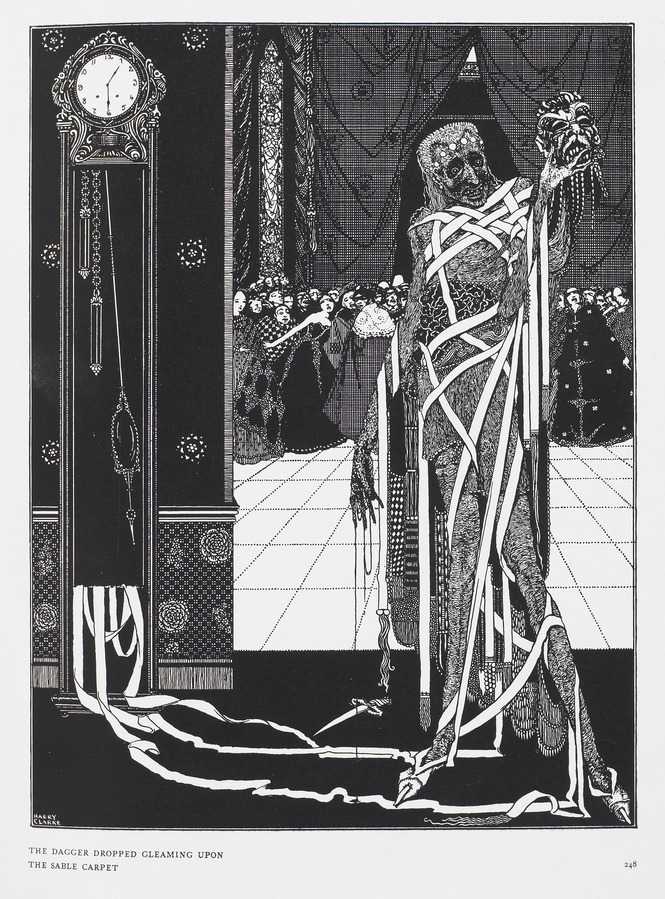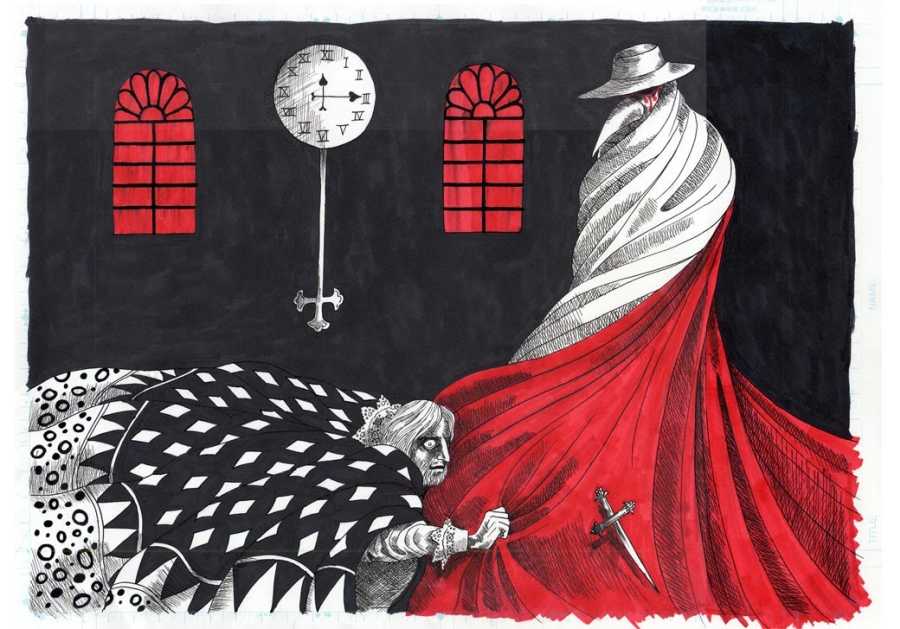Edgar Allen Poe was part of the landscape of Baltimore, when I was a kid. I’m pretty sure every high school English class had to read The Tell-Tale Heart. My favorite story was The Masque of The Red Death.
My parent’s place in France is an old (14th c.) farmhouse down in the south of the country. Dad fell in love with the area and bought an emptied-out shell of a building and re-constructed it back into a livable residence. I don’t remember a lot of that but I’ve seen pictures of what was the dining room with a great big acacia tree growing through the floors and out the roof. Remembering that with my current mind, I boggle at how much energy my dad had and how much work he put into that place. It was great for me, of course – I grew up measuring and sawing chestnut boards for the floors, all with hand-saws because dad was scared of circular saws. Anyhow, we sort of camped out in the place for a few summers, grilling pork steaks from the local butcher over little grills set in coals on the fireplace. There was a huge bay bush (tree) on the side of the house, so we learned to use the wood to flavor the meat. That was how I learned how to cook over open fire – another useful skill. The fireplace was typical of a farmhouse in those days – it was large – about 12′ across, and had stone wings that came forward into the room to catch sparks and reflect the heat. In the day, families would huddle in the fireplace, it being the only part of the building that was warm. So did we.
Dad turned some of those evenings into read-ins. We got through the entirety of The Hobbit, passing the book around and eac of us taking a turn. We also did Shakespeare’s Julius Caesar and Romeo and Juliet and Edgar Allan Poe’s The Gold Bug, The Cask of Amontillado and, The Masque of The Red Death.

The Masque of The Red Death scared the shit out of me. I was probably 9 or so. The house we were sitting in had seen plagues and German occupation and all manner of things and time seemed like a breathable curtain surrounding the little group of humans by the fire. I’ve heard The Masque of The Red Death read in other situations and it just doesn’t compare for setting. Although, I wish I could arrange for someone with a really great voice – perhaps Samuel L. Jackson – to do a reading in the empty streets of some city, perhaps Rome. By a small fire, of course.
This is not a great performance:
https://www.crowdcast.io/e/music-in-the-time-of
but it’s Neil Gaiman. The video starts off with Amanda Palmer doing some Amanda Palmer stuff and about halfway through Gaiman does the reading. They shot it in some church, with a great big pipe organ in the background (which someone should have been playing, though we all know “you do not touch the organ.”

Harry Clarke, 1919
Notre Dame Cathedral had the best damn acoustics. And I suppose during the early periods of its construction it also sheltered little groups of humans clustering around fires, trying to stay warm with eachother’s company. The whole “social distancing” thing is the opposite of our instincts, which is to huddle in our family groups. I wish the politicians and doctors would say that: “look, it’s reasonable to hang out with your person or your special people, but only if you’re not sending an emissary out to deal with others and perhaps invite the Red Death to the party.”

The splendid 1933 Tudor Press edition of Poe’s Tales with illustrations by Harry Clarke is my favorite edition of Poe. At one point in time I had an ebay search set up and would snag every copy that came by for under $50. It’s very “giftable” and that’s how Caine got her copy. There’s a copy on ebay right now for $80 if you’re hankering. Oddly, Clarke does not appear to have done an illustration for The Masque of The Red Death in the 1933 edition – there’s a 1919 illustration by him of a scene from the story. It’s a short story, though the visuals in my imagination are wonderful.
I am including this because it’s the shizznit:

I don’t know who did this but it’s linked on [source]

I’d wager the only people these days not thinking of that story are those who have never read it.
Have to agree with Intransitive @#1. The Partner and I have been talking about that story for weeks.
I love the illustrations. I’ve always admired that style of artwork.
The Poe story is excellent. But me, the book I am thinking of right now is Albert Camus’ La Peste.
I still think he was mostly winding me up.
No, probably not. I have read that there a good number of abandoned ( and sometimes lost) villages in England due to the plague, I expect the same likely occurred in France.
@ 1 Intransitive
I’d wager the only people these days not thinking of that story are those who have never read it.
Me, me! I think this may be the first time I ever heard the title. Poe was not on the Ontario syllabus.
I think I’ll give it a miss at the moment.
You’d lose your wager, Intransitive.
It wasn’t on my syllabus, I only know it from literature/pop culture youtube.
Incidentally, one of said youtubers did a reading of Masque of Red Death, Cask of Amontillado, and a bunch of others recently, if anyone wants another spoken source.
The Cask of Amontillado is my favorite short story of all time.
I still have the Poe book you gave me, on a shelf with my Archie McPhee Poe Action Figure (complete with raven).
I envy you your childhood. I used to read to my son every night; sometimes classics, other times more contemporary fare. Those were the best of times.
My favourite work in the English language is ‘Silence: A Fable’.
publicola@#9:
I envy you your childhood. I used to read to my son every night; sometimes classics, other times more contemporary fare. Those were the best of times.
I was very fortunate. The family that reads together, something somethings.
I’m pretty sure the last illustration is by Edward Gorey.